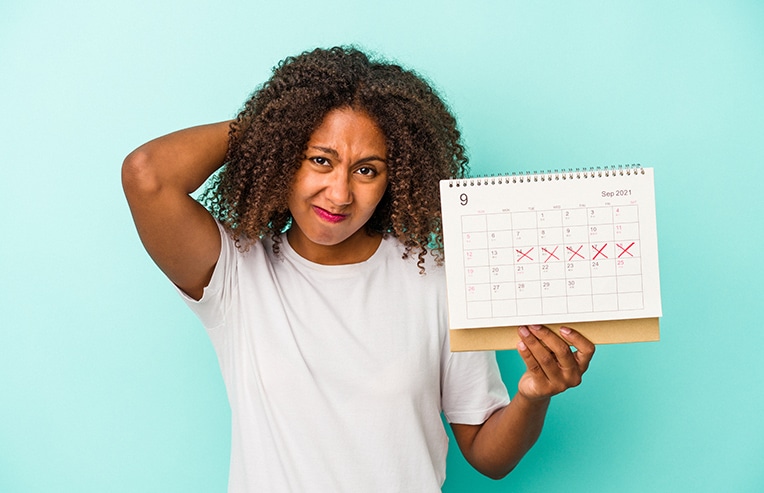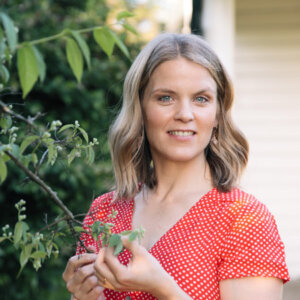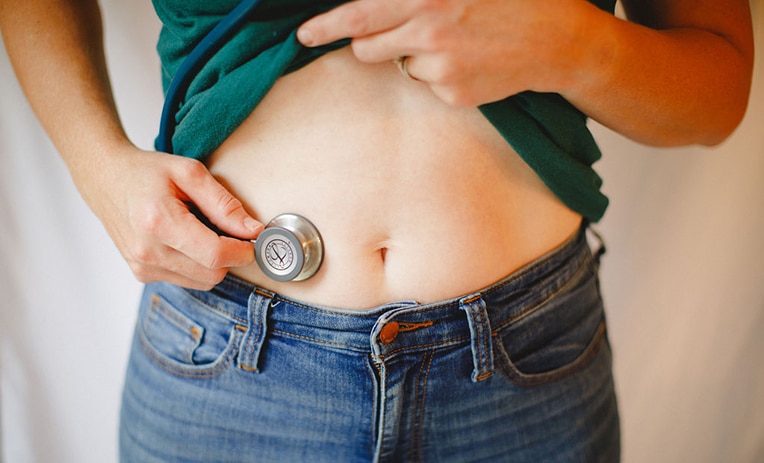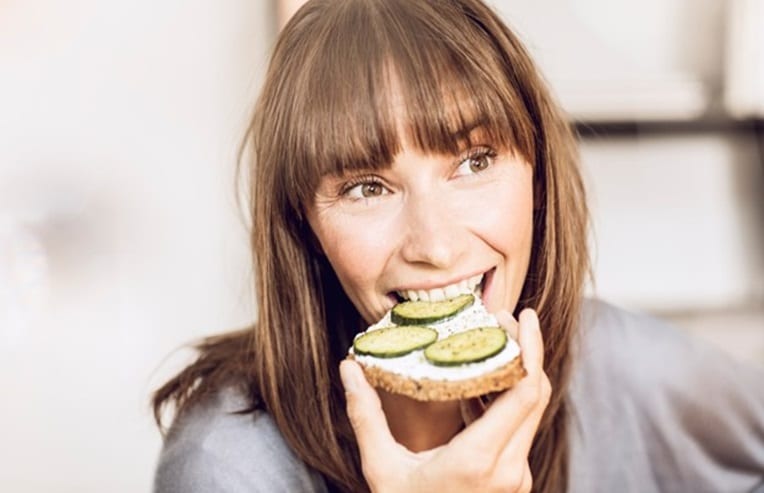If you’re like most women, your period isn’t something you look forward to. After all, who would look forward to bloating, mood swings, fatigue, and cramps?
Despite what millions of women are told, period pain and premenstrual syndrome (PMS) aren’t just “part of being a woman.” They’re powerful signs that something is out of balance.

In this blog, we’ll uncover the root causes of period pain and PMS, explore how inflammation, nutrition, and your unique cycle rhythms play a role, and share holistic strategies to support your body for lasting relief.
Are Period Pain and PMS Normal?
Period pain, also known as dysmenorrhea, affects as many as 95% of women of reproductive age, with up to 29% experiencing severe pain.1 There are two types of dysmenorrhea: primary and secondary.
Primary dysmenorrhea is defined as recurrent lower abdominal menstrual pain that isn’t associated with another disease. It’s a diagnosis of exclusion, meaning it’s a diagnosis made after other potential causes are ruled out. In contrast, secondary dysmenorrhea is associated with an identifiable underlying disease, disorder, or structural abnormality, such as endometriosis, fibroids, adenomyosis, and Crohn’s disease.2,3 Secondary dysmenorrhea also tends to start later in life.
Similarly, research shows that most women of reproductive age experience at least one PMS symptom.4,5 About 20 to 30% of women experience symptoms severe enough to interfere with daily activities.6,7
So yes, PMS and period pain are extremely common – but by no means are they normal. They’re messages that your body is sending you, saying something is out of balance.
Beyond the Symptoms: Understanding the Root Causes of Period Pain and PMS
Far too often, women are told to manage their symptoms with painkillers or hormonal birth control pills. While there’s no denying that conventional medicine can play an important role in symptom relief, these methods don’t identify or address the root causes of your discomfort.
From a holistic medicine practitioner’s perspective, the main culprits of period pain and PMS are: inflammation, hormonal imbalances, and nutritional deficiencies.

How Inflammation Fuels Period Pain and PMS
During the luteal phase (the second half of your menstrual cycle, starting right after ovulation occurs), your body produces high levels of hormone-like substances called prostaglandins. These inflammatory mediators have a range of effects, one of which is to cause the uterus to contract and shed its lining.
Prostaglandins are directly tied to the inflammatory processes in your body. And although acute inflammatory responses are necessary for healing from infection and injury, low-grade chronic inflammation can wreak havoc on your health.
That’s because chronic inflammation can lead to excess prostaglandin production. In turn, excess prostaglandin contributes to further chronic inflammation by recruiting inflammatory cells and amplifying chemicals called cytokines.8 This inflammatory fire is like a “perfect storm” that intensifies menstrual cramps and pain.9
Experts also believe prostaglandins cause narrowing of blood vessels to the uterus. This can lead to reduced blood flow and decreased oxygenation of the uterus, resulting in increased sensitivity of nerve endings.10
The impact of inflammation doesn’t stop at period pain. It can also exacerbate PMS symptoms like bloating, fatigue, headaches, and mood changes.11 Chronic inflammation can also affect other organs, which is why it’s so important to prioritize getting inflammation under control.
The Role of Hormonal Balance in Period Pain and PMS
While inflammation is a key player in period pain and PMS, it often works closely with hormonal imbalances, particularly estrogen dominance. But the term “estrogen dominance” doesn’t necessarily mean excessively high estrogen. It means there’s an imbalance in the estrogen to progesterone ratio.
This imbalance can lead to the overproduction of prostaglandins, which promote inflammation and pain. Research studies show high prostaglandin levels are associated with more intense period pain.12
On the other hand, progesterone is known to have an anti-inflammatory, analgesic effect that is likely to reduce period pain. This is why maintaining a good estrogen-to-progesterone ratio is so important for your well-being.

How Diet and Nutritional Deficiencies Contribute to Period Pain and PMS
There is a complex interplay between nutrition and your menstrual cycle. The answer to your menstruation-related woes may lie in your diet. Let’s look at a few of the main culprits:
- Inadequate omega-3 fatty acids: A diet that is low in anti-inflammatory omega-3 fatty acids can promote inflammation, which can lead to more pain and more severe PMS symptoms.13,14
- Ultra-processed foods and refined sugars: A diet full of ultra-processed foods may just be the biggest contributor to chronic inflammation. Most ultra-processed foods contain refined sugars, artificial additives, and excess salt and sugar. Many research studies show that consumption of ultra-processed foods can disrupt the gut microbiome and lead to chronic inflammation.15
- Nutrient deficiencies: Certain nutrients like calcium, iodine, magnesium, zinc, B vitamins, and vitamin D are essential for regulating inflammation.16,17,18,19,20 Deficiencies in these nutrients are commonly seen in women with PMS and period pain.21 For example, studies show magnesium may help prevent period pain, PMS, and menstrual migraines.22
Holistic Strategies for Healing From PMS and Period Pain
Now let’s explore powerful holistic and actionable strategies you can implement to heal from PMS and period pain.
How to Stop Period Pain Naturally: A Multi-Faceted Holistic Approach
- Eat an anti-inflammatory diet: This is arguably the most important and impactful area you can focus on. Embrace a whole-food, anti-inflammatory diet rich in colorful fruits and vegetables, lots of fiber, lean proteins, and healthy fats. A clean diet will also help improve your gut health, which can further reduce inflammation.
- Load up on omega-3 fatty acids: Foods rich in omega-3 fatty acids include wild-caught salmon, flaxseeds, chia seeds, sardines, and walnuts. You may also want to consider an omega-3 supplement if your intake is insufficient.
- Target nutritional gaps with supplements: While a whole-food, nutrient-dense diet is foundational, it’s not always enough. Targeted supplementation can help address nutritional deficiencies. I recommend consulting with a healthcare professional before starting new supplements.
- Balance stress and tension: Chronic stress is a major contributor to inflammation and hormonal imbalance. When you’re stressed, your body prioritizes production of cortisol (the stress hormone) over sex hormones, which disrupts your menstrual cycle along with many other processes in your body.23 Practice mindfulness and meditation, even if you can commit to only 10 to 15 minutes a day. If needed, I also refer my patients to a physical therapist for pelvic floor pain relief.
- Support detoxification and hormone balance: Your liver and gut are your body’s primary detoxification organs. Support your gut with a healthy anti-inflammatory diet. You can also eat sulfur- and antioxidant-rich foods like garlic, onions, berries, and dark leafy greens to support liver health. Make sure to drink plenty of filtered water to support detoxification.
- Consider herbal allies: Herbal remedies can also be used specifically for pain, inflammation, and hormone balance. Anti-inflammatory herbs like curcumin found in turmeric have been shown to alleviate PMS symptoms and period pain.24 Cramp bark also has a long history of being used for period pain relief. If appropriate, supplements like DIM (diindolylmethane) can be used to regulate estrogen metabolism.25
How to Reduce PMS Symptoms Naturally: Get in Touch With Your Cycle
Healing from PMS involves a comprehensive approach that builds on the same foundational steps as discussed above for period pain. For PMS, I recommend focusing on understanding and working with your body’s unique needs and your cycle.
Here are my recommendations for tuning into your body:
- Cycle tracking: Think of cycle tracking as a step to unlocking your body’s inner wisdom. While it’s not a treatment, cycle tracking is one of the most powerful tools you can use to become intimately familiar with your menstrual cycle. Many women are unaware of their different phases and ovulation patterns, and cycle tracking helps gather this data.26
It’s not just about being able to predict when your next period will start though. It can help identify significant changes in your cycle or lifestyle; track energy levels, mood, food cravings, and symptoms; help determine patterns in your sex drive; and increase your awareness of your overall health. It may even provide clues about hormonal imbalances, such as estrogen dominance or low progesterone, allowing you to act before symptoms become severe.
Check out more tips on connecting with and supporting your menstrual cycle here.
- Hormone tests: Treating PMS at the root often involves hormone testing during the luteal phase. We typically test during this phase because progesterone levels peak approximately 6 to 8 days after ovulation in nonpregnancy cycles.27 By testing for both estrogen and progesterone levels, we can get a picture of whether your symptoms are being caused by a hormonal imbalance. Research suggests that hormone imbalances, such as low progesterone, low estrogen, or high estrogen, are the underlying cause of many PMS symptoms like mood swings, fatigue, and breast tenderness.28
In addition to testing, I recommend working with a healthcare professional to uncover and address the causes of your hormonal imbalance. This may involve lifestyle or diet changes like those we discussed above.
Start Your Holistic Healing Journey
Period pain and PMS symptoms don’t have to be a permanent way of life. Many women find improvements quickly with a dialed-in, whole-person holistic approach. But keep in mind that holistic healing is a journey, not a destination. It requires patience, consistency, and a willingness to connect with your body in ways you may have never done before.
You deserve to live free from monthly pain and PMS symptoms. If you’re ready to begin your holistic healing journey, I’m here to help. Schedule a 15-minute complimentary consultation with me to learn more.
- https://bmcwomenshealth.biomedcentral.com/articles/10.1186/s12905-021-01532-w
- https://www.ncbi.nlm.nih.gov/books/NBK560834/
- https://www.acog.org/womens-health/faqs/dysmenorrhea-painful-periods
- https://pmc.ncbi.nlm.nih.gov/articles/PMC7045079/
- https://www.ncbi.nlm.nih.gov/books/NBK560698/
- https://www.ncbi.nlm.nih.gov/books/NBK560698/
- https://link.springer.com/article/10.1007/s00737-022-01261-5
- https://www.sciencedirect.com/science/article/abs/pii/S0165614712000302
- https://pmc.ncbi.nlm.nih.gov/articles/PMC10178419/
- https://pmc.ncbi.nlm.nih.gov/articles/PMC7068519/
- https://pmc.ncbi.nlm.nih.gov/articles/PMC5311461/
- https://www.sciencedirect.com/science/article/abs/pii/S1130862119303158
- https://pubmed.ncbi.nlm.nih.gov/23642943/
- https://pubmed.ncbi.nlm.nih.gov/35266254/
- https://pmc.ncbi.nlm.nih.gov/articles/PMC6835660/
- https://www.sciencedirect.com/science/article/abs/pii/S0946672X14001503
- https://www.sciencedirect.com/science/article/abs/pii/S1084952120301713
- https://pmc.ncbi.nlm.nih.gov/articles/PMC6943485/
- https://pmc.ncbi.nlm.nih.gov/articles/PMC4070857/
- https://pmc.ncbi.nlm.nih.gov/articles/PMC11013220/
- https://pmc.ncbi.nlm.nih.gov/articles/PMC9928757/
- https://pubmed.ncbi.nlm.nih.gov/28392498/
- https://pmc.ncbi.nlm.nih.gov/articles/PMC5476783/
- https://pmc.ncbi.nlm.nih.gov/articles/PMC10973707/
- https://pmc.ncbi.nlm.nih.gov/articles/PMC3048776/
- https://pmc.ncbi.nlm.nih.gov/articles/PMC7614476/
- https://www.asrm.org/practice-guidance/practice-committee-documents/diagnosis-and-treatment-of-luteal-phase-deciency-a-committee-opinion-2021/
- https://www.ncbi.nlm.nih.gov/books/NBK560698/




